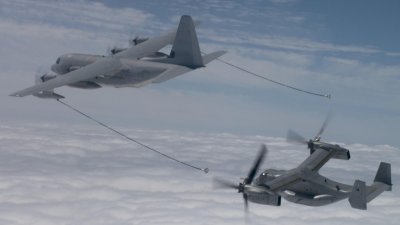Friday
June 16, 2006
USMC MV-22 Osprey completes non-stop flight
PATUXENT RIVER, Md, USA ( Bell Helicopters Press Release ) -
Marine Corps crews successfully completed two
non-stop, coast-to-coast flights this week with a pair of MV-22 Osprey
tiltrotor aircraft, as a precursor to a transatlantic flight to England with
the same Ospreys in July.
The Marine Corps is conducting the long-distance flights to develop tactics,
techniques and procedures for long-range, over-water movements of MV-22s, in
preparation for the first combat deployment in 2007.
"Unlike conventional rotary wing aircraft, which must be transported into
overseas theaters of operation aboard amphibious shipping or heavy lift
transport planes, the V-22 can self-deploy thousands of miles over water to
get itself to the fight," said Col. Bill Taylor, V-22 Osprey joint program
manager.

|
That ability was proven during operational evaluation in 2005, when the
Osprey demonstrated a projected range of more than 2,600 nautical miles on a
single aerial refueling. The MV-22 can be configured with up to three
mission auxiliary tanks in the cabin to enable these kinds of ranges.
Marine Tiltrotor Operational Test and Evaluation Squadron 22 (VMX-22)
launched two Ospreys from their home at Marine Corps Air Station New River,
N.C., Monday, landing at Marine Corps Air Station Miramar, Calif., nine
hours and 2,100 nautical miles later. They returned to New River Thursday,
making that flight in just eight hours. Altitudes on the flights ranged from
14,000 to 16,000 feet, with sustained ground speeds between 240 and 300
knots.
The aircraft were configured with two of the three available auxiliary fuel
tanks. The VMX-22 crews completed two aerial refuelings en route with
KC-130J tankers from Marine Aerial Refueler Transport Squadron 252
(VMGR-252), to further validate the Osprey's long-range fuel system
capabilities in support of future combat deployments.
"We didn't have to do two aerial refuelings, but we wanted to fill up those
[auxiliary fuel tanks] and burn them out a couple times, to increase our
experience with the systems," said Lt. Col. Chris Seymour, VMX-22 executive
officer and pilot of one of the two Ospreys. "The flights have gone
extremely well."
"The mission planning computer systems onboard that help us manage our long
range flights were accurate within a quarter percent of predicted
performance," said Col. Glenn Walters, VMX-22 commanding officer. Actual
flight time, for example, was just three minutes off from the predicted
flight time, on a trip of more than 2,000 miles. "That gives us a great deal
of confidence in over-water flights ... enabling us to make good decisions
on how to get long distances," he said.
This week's overland flights were structured as rehearsals for the
transatlantic deployment to England in July. VMX-22 will depart from Goose
Bay, Newfoundland, July 10, flying direct to Great Britain along with two
tankers from VMGR-252.
Once across the ocean, the aircraft will be turned over under a lease
agreement to manufacturer Bell Boeing, who will operate the aircraft in the
Royal International Air Tattoo and Farnborough International Air Show July
14-23. Farnborough and the Tattoo will be the Osprey's first international
air show appearances since 1995.
The Marine Corps, however, is interested in other firsts.
"This will be the first time that an assault support aircraft has ever flown
across the Atlantic," Taylor said. It will also be the first time in more
than 20 years that Marine Corps KC-130s have supported a transatlantic
deployment, he said.
"This is invaluable as far as establishing the tactics, techniques and
procedures for these types of missions in coordination with the KC-130s,"
Seymour said. "We're writing the book on how to do this."
The Marine Corps is using the opportunity to fly to England as a prudent
first step to gain experience and refine skills, Taylor said, before VMM-263
takes the aircraft across the ocean into a theater of battle.
In March, Marine Medium Tiltrotor Squadron 263 (VMM-263) was established as
the world's first tiltrotor combat squadron. They began receiving Ospreys in
May, and will deploy with the MV-22 after the aircraft reaches initial
operational capability in summer 2007.
Under the current program of record, the Marine Corps will purchase 360
MV-22s for missions including amphibious assault, ship-to-objective maneuver
and sustained operations ashore. The Ospreys will ultimately replace all
CH-46E and CH-53D helicopters for the Corps, delivering twice the speed and
three to five times the range as those platforms. Manufacturer Bell Boeing
began delivering the Block B combat configuration of the Osprey in December
2005.
Secretary of the Navy Dr. Donald C. Winter flew with VMX-22 earlier this
year, to evaluate the aircraft first hand.
"The significance of this program to the Naval services is not about
hardware or technology," Winter said. "It's about what it will mean to our
people. The Osprey can deliver Marines to battle more safely, bring them
reinforcements over greater distances in greater numbers, and evacuate
wounded more quickly. That all equates to lives saved, as we continue to
prosecute the global war on terrorism."
News: VMMT-204 graduates first Osprey crew chiefs ( Feb 8, 2006 )
News: Bell Boeing Delivers First V-22 Block B ( Dec 8, 2005 )
News: DoD Approves V-22 Full Rate Production ( Sep 28, 2005 )
News: MV-22 resume flight testing ( Feb 28, 2002 )
V-22 Osprey
CH-46 Sea Knight
Bell timeline
Boeing timeline
